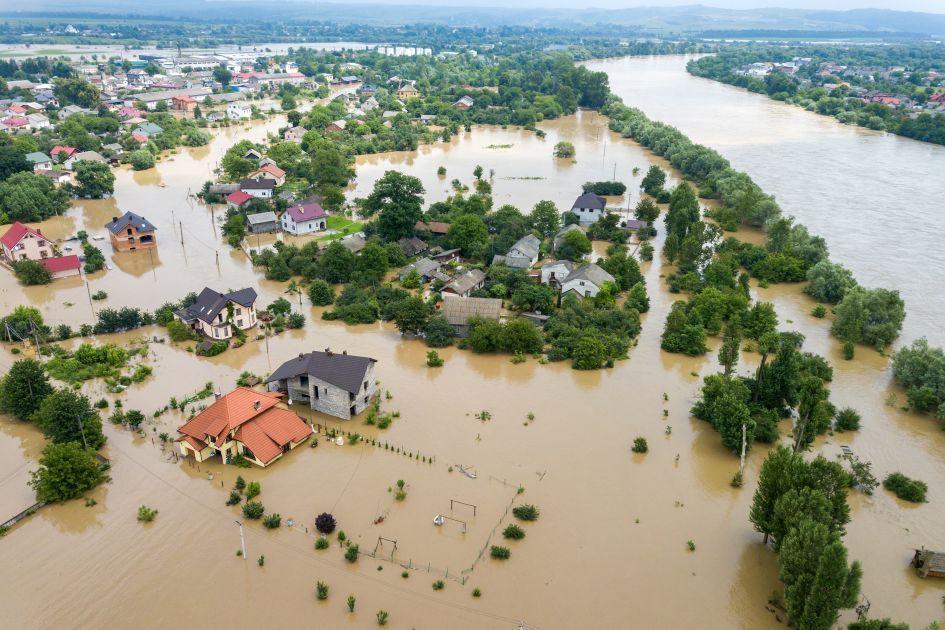Preparing for the Impact of Climate Change: Flooding Response and Mitigation

Editor’s note: Major flooding events are occurring so often that in the days between when this post was drafted and when it was scheduled to publish, another deadly flood struck – this time in Central Europe. We are in contact with our Associates in the region, and are keeping an eye on developing conditions across Romania, Austria, Poland, and the Czech Republic.
“The Vienna River, or simply the Wien, experienced a 1000-year flood event in the recent flood in September 2024. However, due to the recently constructed stormwater retention reservoirs, no damage was caused in the city, " Bastian Schnabel, with our Associate Hydrophil in Austria. In this case because of well-prepared flood protection it mitigated damage to this city of over 2 million. Read on to learn more about flood management, response and mitigation.
One of the most destructive consequences of climate change is the increased frequency of flooding. According to the World Health Organization (WHO), floods are the most frequent natural disaster, representing 44% of all natural disasters worldwide.
As flooding impacts more people and places than ever before, it is imperative that governments, corporate entities, and other regional stakeholders have a response and mitigation plan in place — especially in areas at a higher risk of flooding.
Read on to discover how climate change increases flood risks and the strategies needed for effective response.
Understanding Climate Change and Flooding
Climate change is significantly altering global weather patterns, with one of the most visible and destructive consequences being the increased frequency and intensity of flooding.
Increased precipitation
As global temperatures rise, the atmosphere holds more moisture, leading to heavier and more prolonged precipitation in the form of rain and snow. This, in turn, causes rivers to overflow, storm drains to back up, and low-lying areas to flood more frequently.
Warming oceans also fuel stronger hurricanes and typhoons, which bring both coastal storm surges and inland flooding as they move further over land.
Rising sea levels
One of the major effects of climate change on flooding is the rise in sea levels, which exacerbates coastal flooding, especially during storms. According to the Intergovernmental Panel on Climate Change (IPCC), global sea levels have risen by about 8-9 inches (20-23 cm) since 1880, and nearly half of that rise has occurred in the past 25 years. This acceleration is due to the melting of glaciers and ice sheets as well as the expansion of seawater as it warms.
Record-breaking floods
Recent years have seen record-breaking floods around the world:
Germany, 2021
A devastating series of floods hit Germany, with some regions experiencing flooding of a magnitude that was expected to occur once every century. The event resulted in significant loss of life and infrastructure damage, and experts point to the increasing frequency of such extreme weather due to climate change.
New Zealand, 2022-2023
Over a span of a few months, New Zealand was hit by a series of severe weather events, leading to widespread flooding. The economic cost surpassed $4 billion, and for a country of just 5 million people, the devastation was immense.
Brazil, 2024
Severe flooding in Rio Grande do Sul left entire communities displaced. The floodwaters rose quickly, trapping people in their homes and forcing mass evacuations.
For a more in-depth look at how flooding affected these communities, listen to our podcast Rising above the Floods: Stories from Flood-Affected Communities
Importance of proactive flood management
As climate change continues to influence the environment, integrating climate predictions into urban planning will be crucial for reducing long-term risks. This means considering future flood risks when designing new developments and retrofitting vulnerable areas to withstand extreme weather events.
Only through proactive, adaptive measures can communities stay ahead of the increasing flood risks posed by climate change.
To learn more about how your organization can better prepare for the future, check out our Flood Risk and Climate Resilience Webinar.
Key Challenges in Flooding Response and Mitigation
Flooding poses complex challenges for governments, businesses, and communities. Addressing these issues is critical to minimizing both immediate and long-term impacts.
Increased flood frequency and intensity
Floods are occurring with greater frequency and intensity due to climate change, which leads to more extreme weather patterns like heavier rainfall. What were once considered rare “100-year floods” are now happening more frequently, making it difficult for emergency responders and urban planners to predict and prepare for future events.
Shifting weather patterns
Erratic weather patterns, driven by climate change, have made it increasingly challenging to predict where and when flooding will occur. Previously dry regions are now facing unexpected heavy rainfall. Areas that historically faced low flood risk are now experiencing frequent flooding, complicating flood response efforts.
Overwhelmed and outdated infrastructure
Aging infrastructure in many regions is ill-equipped to manage the intense rainfall associated with climate change. In once-dry areas, stormwater systems, roads, and buildings often cannot cope with sudden downpours, leading to widespread flooding. Coastal areas, already dealing with rising sea levels, face even greater challenges as storm surges and high tides put additional strain on outdated infrastructure.
Economic and Social Impacts of Flooding
Floods not only cause immediate physical damage — they also have long-term economic and social impacts. The destruction of homes, businesses, and critical infrastructure can cripple local economies, leading to job losses, disruptions in services, and increased poverty. It’s predicted that by 2050, flooding could cost the global economy $5.6 trillion.
In addition to the economic toll, floods can have profound social consequences. Displaced populations often face significant health risks, including the spread of waterborne diseases, food shortages, and the psychological trauma of losing homes and livelihoods. Vulnerable populations, such as the elderly, low-income communities, and people with disabilities, are disproportionately affected by floods.
Developing Effective Flood Response and Flood Mitigation Strategies
As the frequency and severity of flooding continue to rise due to climate change, governments, organizations, and communities must adopt more effective strategies to mitigate flood risks and improve response efforts.
Enhanced early warning systems
Early warning systems are a cornerstone of effective flood response, providing communities with crucial lead time to take protective action. The rise of innovative technologies has transformed flood monitoring and response, making it possible to track conditions in real time and detect changes that signal an impending flood.
Remote sensing technologies like satellites and drones provide high-resolution images of flood-prone areas, helping authorities assess damage, track water levels, and identify vulnerable locations. These tools are invaluable for monitoring remote or hard-to-reach regions, ensuring that even the most isolated areas are covered during critical weather events.
Forecasting models use hydrological and meteorological data to predict when and where floods may occur, as well as their potential magnitude. Ensemble forecasting, which combines multiple models, offers a more comprehensive prediction, allowing emergency services to better prepare for and respond to flood threats.
Stream and river gauges are key for monitoring rising water levels in rivers and streams. When integrated with early warning systems, these gauges trigger alerts when water surpasses critical thresholds, enabling rapid response to prevent or mitigate flood damage in affected areas.
Emergency Response Planning and Community Preparedness
Emergency response planning is the backbone of any flood mitigation strategy, and it requires detailed, well-rehearsed protocols.
Developing community-based response plans
Communities are often the first line of defense when it comes to flood response. Developing community-based response plans empowers residents to take ownership of their flood preparedness.
These plans should focus on local risk factors, like proximity to rivers or coastal areas, and outline specific steps for residents to follow during a flood event. Community-based plans should also address the needs of vulnerable populations, such as the elderly, disabled, or low-income families, to ensure they receive additional support during an emergency.
Construct flood-resistant infrastructure
Specific infrastructure measures such as the construction of stormwater retention reservoirs, renaturation of rivers and wetlands, de-paving of urban areas, and the construction of side channels like the Neue Donau (New Danube) build in Vienna in the 1970’s to provide flood relief by channeling excess water out of Vienna City, help to make cities more resilient to flooding events.
Educating the public on flood risks and safety measures
One of the most effective ways to reduce the impact of floods is through public education.
Communities need to be well-informed about flood risks in their area and understand how to protect themselves and their property when flooding occurs.
Public awareness campaigns should cover important topics like:
- How to recognize flood warning signs
- What to include in an emergency flood kit
- How to safely evacuate during a flood
- Steps to protect homes and businesses, such as elevating electrical equipment or using water barriers
Learn more: Global Perspectives: Understanding the Differences in Emergency Response Programs
Planning for a Resilient Future
To build a more resilient future, governments, businesses, and communities need to work together to anticipate and adapt to the evolving nature of risks associated with climate change. This means improving early warning systems, enacting energy transition plans, and investing in resilient infrastructure.
As we look ahead, adopting a holistic approach to climate adaptation — one that incorporates diverse strategies across sectors — will be essential for safeguarding lives, livelihoods, and economies.
Is your entity ready to address disaster preparedness? Learn more about our Emergency Response Programs & Training
Inogen Alliance is a global network made up of dozens of independent local businesses and over 6,000 consultants around the world who can help make your project a success. Our Associates collaborate closely to serve multinational corporations, government agencies, and nonprofit organizations, and we share knowledge and industry experience to provide the highest quality service to our clients. If you want to learn more about how you can work with Inogen Alliance, you can explore our Associates or Contact Us. Watch for more News & Blog updates here and follow us on LinkedIn.

